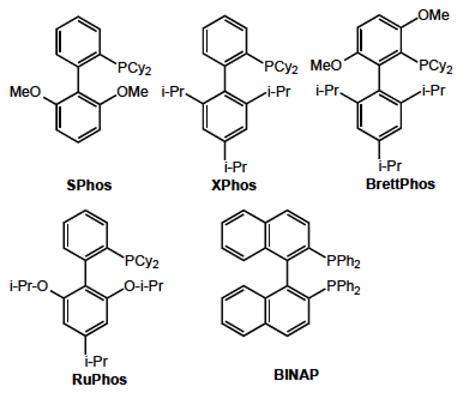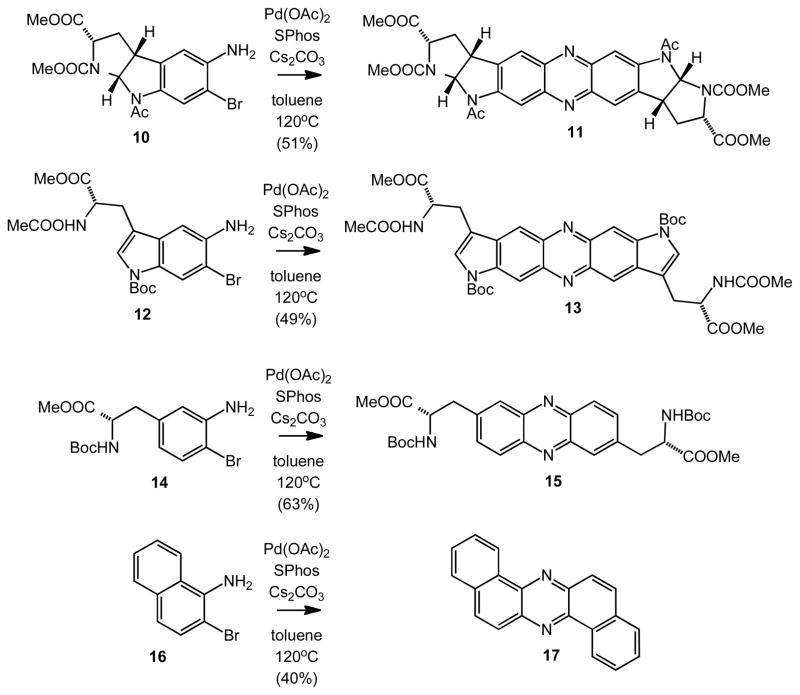Abstract
A new method for the “ligation” of two aromatic rings has been achieved via synthesis of functionalized phenazines by double Buchwald-Hartwig cyclization of a variety of substituted bromoanilines.
The ligation of aromatic rings represents an important tool for the synthesis of molecules of increasing complexity,ii with important applications in the synthesis of natural and unnatural products. We describe here the implementation of such a strategy for the preparation of substituted phenazines,iii leading to the synthesis of disubstituted heterocycles that cannot be otherwise prepared with comparable levels of efficiency (Figure 1).
Figure 1.

Regiochemistry of Synthesis of Disubstituted Phenazines
Previous efforts by Beifussiv and Senanayakev have suggested that such a process should be possible, although with only single examples in unoptimized yields, both of which employ the highly pyrophoric ligand tri-t-butyl phosphine. We report herein the optimization of this process and its implementation as a method of choice for the synthesis of unsymmetrically disubstituted phenazines. We further describe the application of this reaction sequence to the aryl ligation of two molecules of tryptophan to generate the previously unreported heterocyclic ring system 1,7-dihydrodipyrrolo-[2,3-b:2′,3′-i]phenazine, a highly fluorescent pentacyclic ring system.
We report herein that a series of bromoanilines that are substituted with either electron-donating or electron-withdrawing groups can be regioselectively converted to the corresponding disubstituted phenazines in good yields using BINAP or other crystalline phosphine ligands in lieu of tri-t-butyl phosphine (Table 1). Using the Buchwald C-N Ligand Kit available from Strem Chemicals, a series of phosphines were surveyed, and the two ligands that afforded the highest yields are presented in the Table for each substrate, illustrating the absence of a single optimal phosphine ligand in this reaction. Similar results were observed with the 2-chloroaniline (64% yield) although the corresponding triflates resulted only in oxygen to nitrogen triflate migration in lieu of the desired coupling reaction. The last entry in Table 1 is particularly notable as, even though the observed yield is moderate, none of the desired phenazine product was observed with BINAP.vi
Table 1.
The Effect of Phosphine Ligand on Phenazine Yield

| |||||
|---|---|---|---|---|---|
| Entry | R1 | R2 | R3 | R4 | Phosphine ligand (Yield) |
| 3 | H | H | H | H | SPhos (95%) XPhos (95%) |
| 4 | Me | H | H | H | BrettPhos (92%) XPhos (59%) |
| 5 | H | H | H | Me | RuPhos (92%) BrettPhos (71%) |
| 6 | H | t-Bu | H | H | XPhos (55%) SPhos (54%) |
| 7 | H | CF3 | H | H | XPhos (80%) RuPhos (56%) |
| 8 | OMe | H | H | H | RuPhos (72%) BINAP (56%) |
| 9 | H | AcN(Me)− | H | H | XPhos (43%) SPhos (41%) |

| |||||
We next examined the reaction of more complex aminoaromatics derived from amino acid precursors, as outlined in Figure 2. Aryl ligation of tryptophan using this strategy could lead to the previously undescribed dihydrodipyrrolophenazine ring system shown in 13. Toward that end, dimerization of 10,vii leads to the formation of the corresponding phenazine in 51% yield. However, all attempts to convert 11 to the ring-opened product under the reaction conditions described by Hino and coworkers7 led to none of the desired product 13. Direct dimerization of the N-Boc tryptophan 12 produced the desired ring system 15 in 49% yield. The UV spectrum of 13 was notable for a λmax of 406 nm, and the fluorescence spectrum of 13 featured a λem of 538 nm, with a Stokes’ shift of 132.
Figure 2.
Synthesis of Complex Phenazines
The analogous reaction of the phenylalanine-derived substrate 14 afforded the corresponding phenazine 15 in 63% yield. A further example of the regiochemical control that is possible with this phenazine construction strategy is the formation of 17, albeit in 40% yield, from 16, without formation of the corresponding dibenzo[a,j]phenazine, a result that would not be possible using the more classical approaches to the synthesis of substituted phenazines.viii Finally, we demonstrate that this strategy is not limited to dimerization. By judicious choice of substituents on the aniline ring, i.e., by exploiting the decreased reactivity of anilines substituted with electron-withdrawing groups, we have demonstrated that the reaction of 18 with 2-bromoaniline leads to the formation of 19 in 65% yield. The application of this methodology to the synthesis of diverse substituted phenazines is currently underway in our laboratory and our results will be reported in due course.
Figure 3.

Synthesis of an Unsymmetrical Phenazine
Acknowledgments
We grateful acknowledge the invaluable assistance of Professor E. James Petersson (University of Pennsylvania) in obtaining and interpreting the fluorescence data. We also thank Professor Ivan Dmochowski (University of Pennsylvania) for helpful discussions regarding the fluorescence properties of the phenazines, and the donors of the Petroleum Research Fund, administered by the American Chemical Society (ND-48955) for the generous support of this research.
References
- i.We warmly dedicate this manuscript to our friend and colleague Professor Albert Padwa, in grateful acknowledgement of his lifetime of creative accomplishments in organic chemistry.
- ii.For an excellent discussion of increasing molecular complexity, see Corey EJ, Cheng X-M. The Logic of Chemical Synthesis. Wiley; New York: 1995.
- iii.For an excellent recent review, see Beifuss U, Tietze M. Top Curr Chem. 2005;244:77.
- iv.Reference 3, p. 109.
- v.Shen M, Li G, Lu B, Hossain A, Roschangar F, Farina V, Senanayake C. Org Lett. 2004;6:4129. doi: 10.1021/ol048114t. [DOI] [PubMed] [Google Scholar]
- vi.All compounds were characterized by full spectroscopic (NMR, IR, high resolution MS) data. Yields refer to spectroscopically and chromatographically homogeneous (>95%) materials. General experimental procedure: To a solution of bromide (1 equiv) in toluene (0.1 M) was added Cs2CO3 (2.0 equiv), phosphine ligand (0.08 equiv), and Pd(OAc)2 (0.05 equiv) at room temperature. The reaction mixture was allowed to stir and warm to 120 °C for 4–4 h. Once the reaction appeared to be complete by consumption of the bromide by TLC analysis, the mixture was allowed to cool to room temperature, diluted with CHCl3, and filtered through celite. The solution was concentrated, loaded on silica gel, and purified by silica gel chromatography. Selected spectral data—14: 1H NMR (CDCl3, 500 MHz): d = 8.91 (bs, 2H), 8.36 (s, 2H), 7.71 (s, 2H), 5.48 (d, J = 7.3 Hz, 2H), 4.81–4.88 (m, 2H), 3.77 (s, 6H), 3.71 (s, 6H), 3.30–3.48 (m, 4H), 1.78 (s, 18H). 13C NMR (CDCl3, 125 MHz): d = 171.9, 156.3, 149.2, 141.2, 139.7, 137.7, 136.3, 130.4, 116.9, 114.8, 112.7, 84.4, 53.6, 52.6, 52.4, 28.2, 27.9. FTIR (thin film) 3310, 2954, 1726, 1536, 1425, 1374, 1329, 1254, 1153, 1067, 855 cm−1. [α]D25 = 20.7 (c = 0.33, CDCl3). HRMS (ES) Calcd. for C38H44N6O12: 799.2915 (M+Na+), found 799.2934 (M+Na+); 18: 1H NMR (CDCl3, 500 MHz): d = 9.49 (d, J = 7.8 Hz, 1H), 8.19 (d, J = 9.2 Hz, 1H), 8.11 (d, J = 9.2 Hz, 1H), 8.00 (d, J = 6.9 Hz, 1H), 7.79–7.89 (m, 2H). 13C NMR (CDCl3, 125 MHz): d = 142.1, 141.9, 133.5, 132.4, 131.4, 129.5, 128.4, 127.9, 127.7, 125.3. FTIR (thin film) 2919, 2851, 1727, 1458, 1382, 1341, 1258, 1115, 827, 741. HRMS (ES) Calcd. for C20H12N2: 281.1079 (M+H+), found 281.1080 (M+H+); 20: 1H NMR (CDCl3, 500 MHz): d = 9.11 (d, J = 1.9 Hz, 1H), 8.77 (d, J = 1.9 Hz, 1H), 8.34 (m, 1H), 8.27 (m, 1H), 7.87–7.95 (m, 2H), 4.13 (s, 3H), 4.06 (s, 3H). 13C NMR (CDCl3, 125 MHz): d = 166.7, 165.6, 144.7, 144.2, 142.4, 142.3, 136.4, 132.4, 132.2, 131.9, 131.0, 130.7, 130.6, 130.1, 53.1, 53.0. FTIR (thin film) 1725, 1600, 1520, 1435, 1329, 1244, 1099, 1030, 755. HRMS (ES) Calcd. for C16H12N2O4: 297.0875 (M+H+), found 297.0873 (M+H+).
- vii.Prepared from the known amino compound (Taniguchi M, Gonsho A, Nakagawa M, Hino T. Chem Pharm Bull. 1983;31:1856.by 1) Boc protection; 2) bromination; and 3) Boc deprotection. For an excellent review on the chemistry of hexahydropyrroloindoles, see Crich D, Banerjee A. Acc Chem Res. 2007;40:151. doi: 10.1021/ar050175j.
- viii.For a discussion of the regiochemistry of phenazine formation, see Kosugi Y, Itoho K, Okazaki H, Yanai T. J Org Chem. 1995;60:5690.



